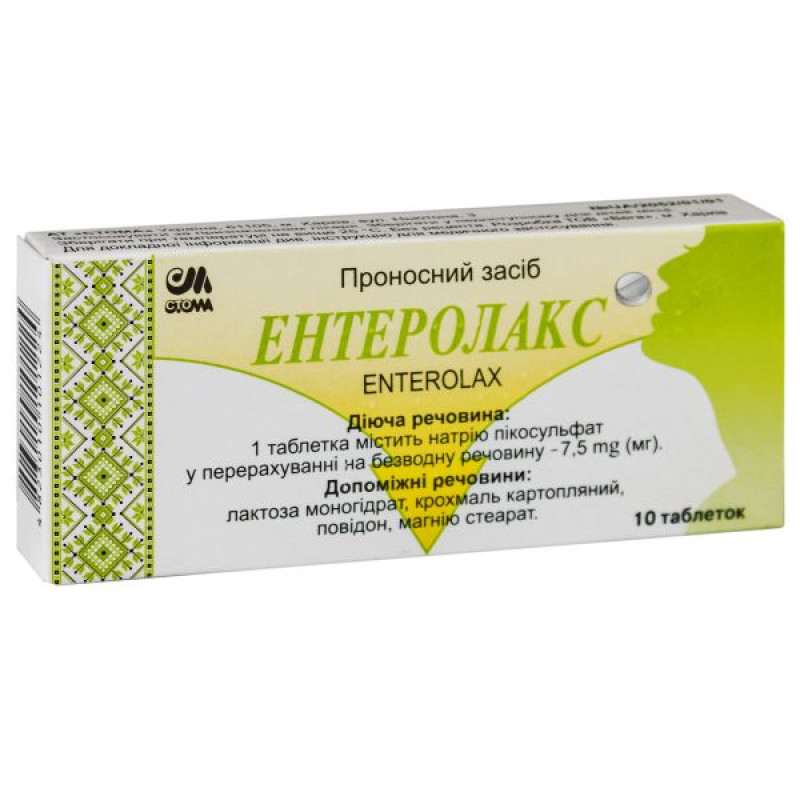Enterolax tablets 7.5 mg No. 10

Enterolax tablets are used for constipation or cases that require easier bowel movements. Like other laxatives, Enterolax should not be used daily or for a long period of time without determining the cause of the constipation.
Composition
The active substance is sodium picosulfate (one tablet contains 7.5 mg of sodium picosulfate as an anhydrous substance).
Excipients: lactose monohydrate, potato starch, povidone, magnesium stearate.
Contraindication
hypersensitivity to the active substance, other triarylmethanes or to any of the excipients of the medicinal product; intestinal obstruction or acute disease of the abdominal organs, for example, appendicitis; acute inflammatory bowel diseases; acute abdominal pain, which is accompanied by nausea and vomiting and may indicate the above acute diseases; severe dehydration.Method of application
Adults should take one tablet (7.5 mg) in the evening before bedtime to ensure bowel movement in the morning.
Enterolax should not be used daily or for a long period of time without determining the cause of constipation.
Application features
Pregnant women
For safety reasons, if possible, Enterolax should not be used during pregnancy.
The active metabolite bis(p-hydroxyphenyl)pyridyl-2-methane (BHPM) and its glucuronides do not pass into breast milk. Thus, Enterolax can be used during breastfeeding.
Children
Do not use on children.
Drivers
Possible development of adverse reactions such as dizziness and/or syncope due to vasovagal reactions (in particular abdominal spasm). In the event of abdominal spasm, the patient should avoid potentially hazardous activities such as driving or operating machinery.
Overdose
Symptoms: when using large doses - intestinal spasms, diarrhea, disturbances of water and electrolyte balance, in particular - hypokalemia, muscle weakness, ischemia of the mucous membrane of the large intestine.
With prolonged use of the drug in significantly increased doses, the following are possible: chronic diarrhea, abdominal pain, secondary hyperaldosteronism, kidney stone formation, damage to the renal tubules, metabolic alkalosis, and muscle weakness as a result of hypokalemia.
Treatment: discontinuation of the drug, induction of vomiting, gastric lavage, administration of enterosorbents (activated charcoal), symptomatic therapy aimed at normalizing water and electrolyte balance and maintaining vital functions, antispasmodics if indicated.
Side effects
With short-term use of the drug, side effects are rarely observed.
With prolonged use of the drug in significantly increased doses, the following disorders are possible:
from the immune system: hypersensitivity reactions, including angioedema, skin rashes, urticaria, itching; from the digestive system: rarely - dyspeptic phenomena, nausea, vomiting, cramps and pain in the abdomen, diarrhea, flatulence, pain in the stomach and anus, increased intestinal motility, which pass when the dose of the drug is reduced; from the water-electrolyte balance: loss of fluid, potassium and other electrolytes; this, in turn, can lead to muscle weakness and impaired cardiac function, especially when the drug is used simultaneously with diuretics or corticosteroids; from the central nervous system: very rarely - headache, increased fatigue, drowsiness, convulsions, dizziness, syncope (the likelihood of dizziness and syncope is associated with a vasovagal reaction (such as abdominal spasm or defecation)).Storage conditions
Store at a temperature not exceeding 25 °C, out of the reach of children.
Shelf life - 3 years.
There are no reviews for this product.
There are no reviews for this product, be the first to leave your review.
No questions about this product, be the first and ask your question.









